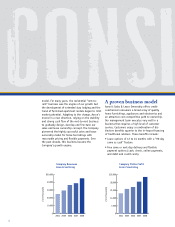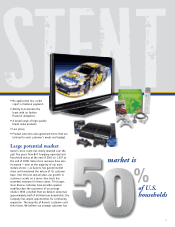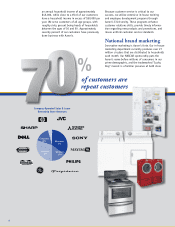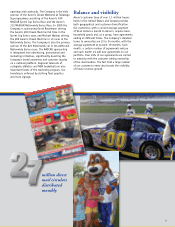Aarons 2008 Annual Report Download - page 18
Download and view the complete annual report
Please find page 18 of the 2008 Aarons annual report below. You can navigate through the pages in the report by either clicking on the pages listed below, or by using the keyword search tool below to find specific information within the annual report.
Rental Merchandise
Our sales and lease ownership division depreciates merchandise
over the agreement period, generally 12 to 24 months when
rented, and 36 months when not rented, to 0% salvage value.
Our policies require weekly rental merchandise counts by store
managers and write-offs for unsalable, damaged, or missing
merchandise inventories. Full physical inventories are generally
taken at our fulfillment and manufacturing facilities on a
quarterly basis with appropriate provisions made for missing,
damaged and unsalable merchandise. In addition, we monitor
rental merchandise levels and mix by division, store and fulfill-
ment center, as well as the average age of merchandise on hand.
If unsalable rental merchandise cannot be returned to vendors,
its carrying value is adjusted to net realizable value or written
off. All rental merchandise is available for rental and sale.
We record rental merchandise carrying value adjustments on
the allowance method, which estimates the merchandise losses
incurred but not yet identified by management as of the end of
the accounting period. Rental merchandise adjustments totaled
$34.5 million, $29.0 million, and $20.1 million for the years
ended December 31, 2008, 2007, and 2006, respectively.
Leases and Closed Store Reserves
The majority of our company-operated stores are operated from
leased facilities under operating lease agreements. The majority
of these leases are for periods that do not exceed five years.
Leasehold improvements related to these leases are generally
amortized over periods that do not exceed the lesser of the lease
term or five years. While a majority of our leases do not require
escalating payments, for the leases which do contain such
provisions we record the related lease expense on a straight-line
basis over the lease term. Finally, we do not generally obtain
significant amounts of lease incentives or allowances from
landlords. The total amount of incentives and allowances
received in 2008, 2007, and 2006 totaled $946,000, $1.4 million,
and $1.5 million, respectively. Such amounts are recognized
ratably over the lease term.
From time to time, we close or consolidate stores. Our
primary cost associated with closing or consolidating stores
is the future lease payments and related commitments. We
record an estimate of the future obligation related to closed or
consolidated stores based upon the present value of the future
lease payments and related commitments, net of estimated
sublease income which we base upon historical experience. For
the years ended December 31, 2008 and 2007, our reserve for
closed or consolidated stores was $3.0 million and $1.3 million,
respectively. If our estimates related to sublease income are
not correct, our actual liability may be more or less than the
liability recorded at December 31, 2008.
Insurance Programs
Aaron Rents maintains insurance contracts to fund workers
compensation, vehicle liability, general liability and group health
insurance claims. Using actuarial analysis and projections, we
estimate the liabilities associated with open and incurred but
not reported workers compensation, vehicle liability and general
liability claims. This analysis is based upon an assessment of the
likely outcome or historical experience, net of any stop loss or
other supplementary coverage. We also calculate the projected
outstanding plan liability for our group health insurance program.
Our gross liability for workers compensation insurance claims,
vehicle liability, general liability and group health insurance was
$19.7 million and $13.6 million at December 31, 2008 and 2007,
respectively. In addition, we have prefunding balances on deposit
with the insurance carriers of $20.0 million and $17.7 million at
December 31, 2008 and 2007, respectively.
If we resolve insurance claims for amounts that are in excess
of our current estimates and within policy stop loss limits,
we will be required to pay additional amounts beyond those
accrued at December 31, 2008.
The assumptions and conditions described above reflect
management’s best assumptions and estimates, but these items
involve inherent uncertainties as described above, which may
or may not be controllable by management. As a result, the
accounting for such items could result in different amounts
if management used different assumptions or if different
conditions occur in future periods.
Same Store Revenues
We believe the changes in same store revenues are a key perfor-
mance indicator. The change in same store revenues is calculated
by comparing revenues for the year to revenues for the prior
year for all stores open for the entire 24-month period, exclud-
ing stores that received rental agreements from other acquired,
closed, or merged stores.
Results of Continuing Operations
Year Ended December 31, 2008 Versus
Year Ended December 31, 2007
The Aaron’s Corporate Furnishings division is reflected as a
discontinued operation for all periods presented. The following
table shows key selected financial data for the years ended
December 31, 2008 and 2007, and the changes in dollars and as a
percentage to 2008 from 2007.
16
























